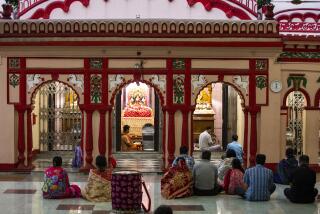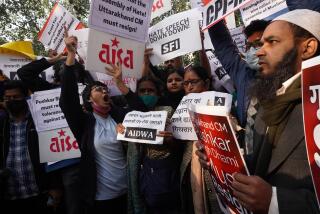Attacks Cause Jitters : New Delhi--’Terror-itis’ Infects Capital
- Share via
NEW DELHI — Government ministers pass through the streets in armed convoys, police carbines sprouting from the windows of the escort cars.
Workers at the Modern School, one of the city’s elite private high schools, are rushing to complete a massive new outer wall topped with iron spikes.
Moviegoers in Connaught Place, in the heart of the city, are frisked before they can take their seats. A psychiatrist says his patients’ dreams are haunted by visions of bearded men on motor scooters carrying Sten guns.
What is going on in the Indian capital? What kind of madness has gripped this city of 5 million people that was once celebrated for its carefree ways and crime-free streets? Why are armed men crouched behind sandbags at many major intersections after dark?
Preoccupied With Security
“Delhi’s got a bad case of terror-itis,” the magazine India Today commented in an article on the manic preoccupation with security.
“The paranoid potential has been absolutely stirred up,” said Sudhir Kakar, a Freudian psychiatrist whose patients are plagued by terrorist nightmares.
Although still in the early stages by Beirut standards, Delhi is learning firsthand about the terrorist attacks that in India were once all but limited to the state of Punjab. Many of the latest attacks have been carried out by bearded men on scooters, hence the dream image.
Only three years ago, the Indian capital was a remarkably open place where ordinary citizens could walk onto the prime minister’s lawn with hardly a glance from the security guards. “They didn’t even check for arms,” Kakar recalled.
In fact, the late Prime Minister Indira Gandhi held a morning audience--a darshan-- so that her followers could come and sit before her in her garden.
Killed in Her Garden
In India, saints and prime ministers are among those believed to radiate waves of power and good will that wash over those who are near them. People “take darshan” or literally, bask in the vision, of the spiritually or politically powerful. Indira Gandhi, who had an enormous popular following, used her darshan to great political advantage.
Then, in October, 1984, she was assassinated in the same garden by two Sikhs on her own security staff. In the days following the assassination, several thousand Sikhs were slaughtered by Hindu mobs in the capital and surrounding areas of northern India.
Sikh extremists--members of the movement to create an independent Sikh homeland in Punjab state--retaliated by killing several Delhi politicians they believe incited the Hindu mobs. In the last year, the separatist movement has evolved into a terrorist campaign against random Hindus in an attempt to drive a wedge between the two traditionally close religions, Hinduism and Sikhism.
Increasingly, the terrorist violence that was once isolated in Punjab state has moved into the capital.
Today, it takes seven searches to reach the interior of the Race Course Road residential compound of Prime Minister Rajiv Gandhi, Indira Gandhi’s son and successor. The security has deprived the prime minister of the darshan except for the most staged and sanitized events. Consequently, he is criticized for his aloofness and his distance, both physically and spiritually, from the masses.
Terrorist attacks in June, July and August of this year fueled the fears. The worst incident occurred in June, when two teen-agers with Sten guns--British-made 9-millimeter submachine guns--opened fire on a garden party in a middle-class neighborhood of southern New Delhi, killing 10 people and wounding 20.
Since then, even the rumor of an attack or the loud backfire of a motor vehicle is enough to send parents scurrying to schools to withdraw their children.
“Immediately after an attack,” journalist Simran Bhargava observed in India Today, “the city recoils, people shun restaurants and lock themselves into their homes. The small shopkeepers pull their shutters down. The city’s parks lose their early morning joggers. Even the pavement dwellers disappear in search of safer pastures.”
Parents Hurried to Schools
A scare in early August sent middle-class parents scrambling to private schools scattered around the city to pull their children out. At the exclusive Delhi Public School, on busy Mathura Road, parents’ cars were parked three-abreast in the street. The principal, N. Kapoor, had to make an appeal for calm.
“We are not going to let panic prevail here,” she said. “I want to make it clear that once parents send their children to school they should let them remain there. We are taking all possible precautions for their safety.”
A few days later, the schoolyard resounded with its normal chatter as students filed through the gates guarded by armed policemen.
Rumors of terrorist attacks on Aug. 15, the 40th anniversary of Indian independence, kept the city’s larger hotels empty of the revelers that customarily gather for the occasion. Movie theaters report significant declines in evening and night business over the last several weeks. Wanted posters with menacing portraits of suspected terrorists are plastered on theater walls. In the theater lobbies, policemen search ticket-holders.
Fears Seem Out of Place
Such emphasis on security does not seem to fit in a society described by former U.S. Ambassador John Kenneth Galbraith as a “functioning anarchy.” Urban India, with its recklessly chaotic streets and diverse populace--men in three-piece suits compete for sidewalk space with naked ascetics--is an unlikely police state.
Until recently, in fact, the closest thing most of India had to a security system was house-watchers-- chowkidars-- men who sit in the lanes in front of houses.
In the Hindi language, the word chowkidar means literally “man who possesses a chair,” and in fact once the chowkidar is ensconced in his chair he is almost impossible to rouse. The chowkidar’s ability to sleep is legendary.
The unarmed chowkidars are theoretically employed to scare off thieves and burglars. Some have been replaced in private homes by professional guard agencies employing former soldiers.
But even these men are helpless against a gun-toting attacker. In fact, Indian faith in the guard system is justifiably not great.
Gandhi’s Guards Relax
India Today magazine reported in a recent issue that the guards assigned to Rajiv Gandhi’s home are monitored by a remote television system. The magazine reported that the guards have learned to time the sweep of the remote camera so that when they are not in view they can sip hot tea and eat vegetable cakes brought them by local vendors.
Thus the troublesome problem faced by the police here: How do you secure a city for which security is a largely alien concept?
K.K. Paul, the deputy inspector general of police in charge of security, reckons that the last time India faced a similar security problem was in the early 19th Century, when travelers were often attacked by a roving criminal brotherhood known as thugees, who gave rise to the English word thug. Wealthy Indians and landholders were advised to hire bodyguards, and some hired bands of thugees.
“That was the last time in history when people were forced to take these kinds of precautions,” said Paul, who has a Ph.D. in chemistry and one of the most precarious jobs in government.
Assailant Hid in Tree
His two immediate predecessors were both fired, one after Indira Gandhi’s assassination, because her killers were members of the police security force, and one last year after an assassination attempt on Rajiv Gandhi by a man hiding in a tree that at the time was surrounded by policemen. The man had been in the tree for days, having brought with him food, water and a toothbrush. Still, a police search had failed to disclose his presence.
In Paul’s office during a recent interview, a giant air conditioner purred in one corner and a computer terminal gave the room an air of cybernetic efficiency.
But in the outer office, a police sergeant assigned to Paul slept in a chair. Around him, well-dressed, impatient-looking Indian couples waited to talk with Paul about getting police bodyguards for their families.
“Police bodyguards have become status symbols,” said Kuldip Nayar, a journalist who until eight months ago had a contingent of guards stationed outside his Delhi bungalow.
Assigned Full-Time Guards
About 800 Delhi families have been assigned full-time guards, including members of Parliament, Supreme Court justices and other senior officials. Each is assigned 2 to 11 men.
Paul said that guards have also been assigned to about 200 “protected persons” who are believed to be under threat of terrorist attack because they oppose the Sikh separatist movement.
In Nayar’s case, the guards were provided because Nayar and several other journalists were named in what the police said were “hit lists” provided by captured terrorists.
Nayar, however, was one of those who do not appreciate the presence of armed men in his life.
“They occupied our front lawn,” he complained. “We had to provide them with fans during the summer and heaters during the winter. They wanted tea morning, noon and night.”
Finally, after several months of appealing to police officials, Nayar’s bodyguards were withdrawn.
“That is one of our problems,” Paul said. “Some of the people who need the guards want to get rid of them. And some of the people who don’t need them want to have them.”
More to Read
Sign up for Essential California
The most important California stories and recommendations in your inbox every morning.
You may occasionally receive promotional content from the Los Angeles Times.













